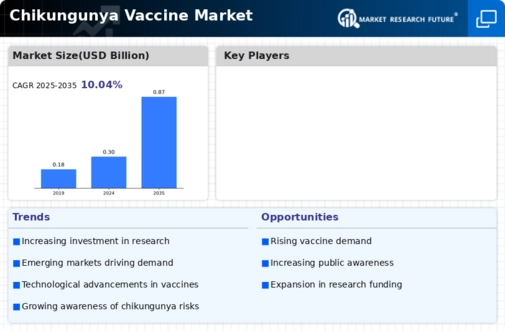Market Analysis
In-depth Analysis of Chikungunya Vaccine Market Industry Landscape
Diseases transmitted by mosquitoes, commonly known as mosquito-borne infections, are illnesses that spread when a person gets bitten by an infected mosquito. Notable examples of such diseases include the Zika virus, West Nile virus, chikungunya virus, dengue, and malaria. Scientists are growing increasingly concerned due to the significant uptick in the rate of infection transmission in recent years, and there is apprehension that global warming may further accelerate the spread of illnesses carried by mosquitoes.
According to data from the World Mosquito Program, approximately 390 million people contract dengue each year, and hundreds of thousands more are affected by other mosquito-borne diseases such as chikungunya, Zika, and yellow fever. Chikungunya infection manifests with symptoms like fever, severe joint pain, muscle pain, joint swelling, headache, nausea, fatigue, and rash. Notably, the joint and muscle pain can persist for months or even years after the initial viral infection. This prolonged impact underscores the seriousness of these diseases and the need for effective preventive measures.
Preventing the transmission of mosquito-borne infections has become a priority for many individuals, considering the alarming infection rates and potential long-term consequences. The global chikungunya vaccine market has witnessed significant growth as people become more aware of the risks associated with mosquito-transmitted infections and seek ways to protect themselves.
One of the prevalent mosquito-borne diseases, dengue, affects millions of people annually. The World Mosquito Program data highlights the substantial burden this disease places on global health. Chikungunya, another mosquito-borne virus, leads to various symptoms, including severe joint pain that can persist long after the initial infection has passed. This persistence of symptoms underscores the urgency of developing effective vaccines to combat these diseases.
Awareness campaigns have played a crucial role in educating the public about the risks posed by mosquito-transmitted infections. By understanding the importance of preventive measures, individuals can take steps to safeguard themselves from mosquito bites and reduce the likelihood of infection. The emphasis on awareness has not only contributed to individual protection but has also fueled the growth of the global chikungunya vaccine market.
The rise in infection rates and the potential global impact of mosquito-borne diseases have spurred efforts to develop vaccines that can offer protection against these illnesses. The chikungunya vaccine market has become a crucial component of public health initiatives, aiming to curb the spread of diseases transmitted by mosquitoes.
The increase in the prevalence of mosquito-borne infections has heightened global concerns, with scientists closely monitoring the potential impact of climate change on disease transmission. With millions of people affected by diseases like dengue, chikungunya, Zika, and yellow fever each year, the need for effective preventive measures is evident. The chikungunya vaccine market has responded to this need, experiencing growth as people prioritize protecting themselves from these mosquito-transmitted infections. Public awareness and ongoing research efforts are essential in the collective fight against mosquito-borne diseases, emphasizing the importance of vaccination as a key preventive measure.




Leave a Comment